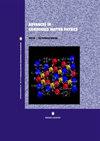Computation of the Dielectric and Optical Properties of Dimethylammonium Tin Triiodostanate (II) Perovskite for Solar Cell Application
IF 1.8
4区 物理与天体物理
Q3 PHYSICS, CONDENSED MATTER
引用次数: 0
Abstract
Hybrid halide perovskites are promising photovoltaic materials for use in solar cells. The ongoing research on perovskites have shown that these materials are potential light-harvesting mediums. The optical properties of dimethylammonium triiodostanate (II) (DASnI3) a hybrid halide perovskites needs to be studied because it can be a good light absorber material due to the wide band gap exhibited. The real and the imaginary parts of the dielectric is a measure of the extent of light absorption. The GGA+U exchange-correlation implemented in Quantum ESPRESSO was used basing on density functional theory to obtain the optical properties. The DASnI3 has a direct band gap of 2.7 eV with the real part of the dielectric diagram indicating that the maximum value of ε1 (ω) is in the visible range of (3.0–3.5 eV). High absorption peaks were also observed in the visible spectral region at energy of around (3.5–4.5 eV) with several weak peaks observed in the energy range of (4.5–14.0 eV). The band structure and the dielectric functions are important in the study of optical properties. These properties expresses the interaction of light with the material medium and thus the luminescence of the device which are important in the use of DASnI3 as a solar cell material in photovoltaics.三碘酸二甲基锡铵钙钛矿的介电和光学性质的计算(II)太阳能电池应用
杂化卤化物钙钛矿是一种很有前途的太阳能电池光伏材料。正在进行的钙钛矿研究表明,这些材料是潜在的光收集介质。杂化卤化物钙钛矿二甲基三碘酸铵(DASnI3)具有较宽的带隙,是一种良好的光吸收材料,其光学性质值得进一步研究。电介质的实部和虚部是光吸收程度的量度。基于密度泛函理论,利用量子ESPRESSO中实现的GGA+U交换相关来获得其光学性质。DASnI3的直接带隙为2.7 eV,介电图实部表明ε1 (ω)的最大值在可见光范围(3.0-3.5 eV)内。在3.5 ~ 4.5 eV的可见光谱区也有较高的吸收峰,在4.5 ~ 14.0 eV的可见光谱区有几个弱吸收峰。带结构和介电函数在光学性质研究中具有重要意义。这些特性表达了光与材料介质的相互作用,从而表达了器件的发光,这对于将DASnI3用作光伏电池材料非常重要。
本文章由计算机程序翻译,如有差异,请以英文原文为准。
求助全文
约1分钟内获得全文
求助全文
来源期刊

Advances in Condensed Matter Physics
PHYSICS, CONDENSED MATTER-
CiteScore
2.30
自引率
0.00%
发文量
33
审稿时长
6-12 weeks
期刊介绍:
Advances in Condensed Matter Physics publishes articles on the experimental and theoretical study of the physics of materials in solid, liquid, amorphous, and exotic states. Papers consider the quantum, classical, and statistical mechanics of materials; their structure, dynamics, and phase transitions; and their magnetic, electronic, thermal, and optical properties.
Submission of original research, and focused review articles, is welcomed from researchers from across the entire condensed matter physics community.
 求助内容:
求助内容: 应助结果提醒方式:
应助结果提醒方式:


